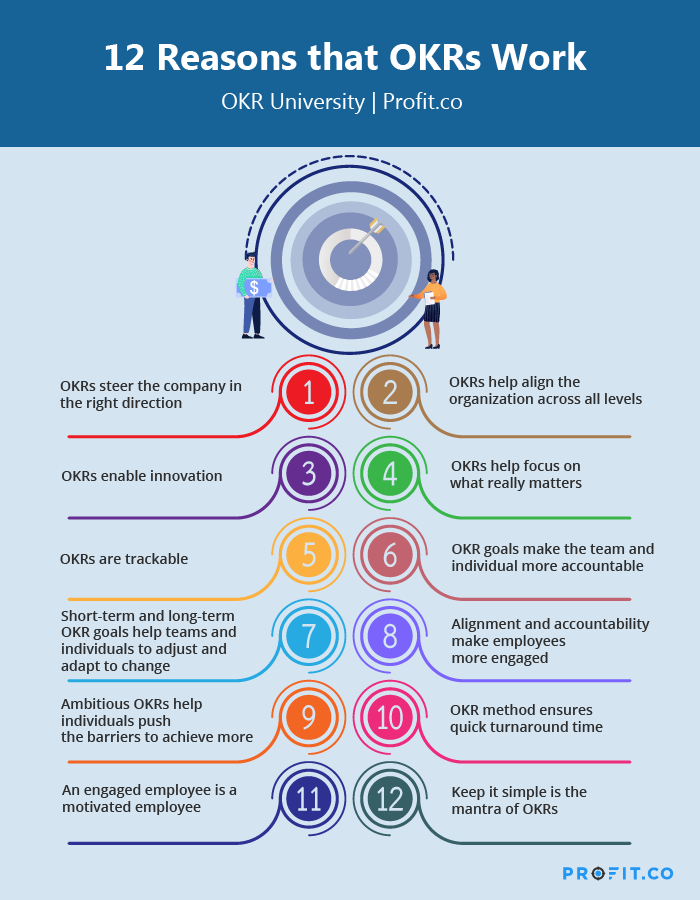Good business leaders create a vision, articulate the vision, passionately own the vision, and relentlessly drive it to completion.
OKRs are not just a management tool, but it fosters a culture of collaboration to achieve the common organizational goal. OKRs have many benefits, but let’s take a look at why OKRs are so effective, and how they work:
- OKRs steer the company in the right direction
- OKRs help align the organization across all levels
- OKRs enable innovation
- OKRs help focus on what really matters
- OKRs are trackable
- OKR goals make the team and individual more accountable
- Short-term and long-term OKR goals help teams and individuals to adjust and adapt to change
- Alignment and accountability make employees more engaged
- Ambitious OKRs help individuals push the barriers to achieve more
- OKR method ensures quick turnaround time
- An engaged employee is a motivated employee
- Keep it simple is the mantra of OKRs

1. OKRs steer the company in the right direction
One of the main functions of OKRs is to give direction to the organization, which only works if everyone is aware of them. Creating that awareness amongst employees isn’t an easy task. At a very basic level, it requires the organization to build habits and rituals as part of the OKR framework.
And figuring out these habits and rituals also doesn’t come easy. It takes time. Once the ideas for how to create awareness of company OKRs have been decided, it needs to be set in motion, and its progress checked as a group every two weeks.
2. OKRs help align the organization across all levels
Lack of alignment across various levels translates into complete confusion. That’s where OKRs play a role in getting the entire organization aligned.
OKRs connect every department, team, and employee towards the big organizational goal. Top management sets the goal for the organization. This cascades to the departments, teams, and down to the individual employee. What this means is, individual goals should be informed by team goals, team goals should be informed by department goals, and department goals should be informed by company goals.Therefore, knowing what the organizational-level goals are helps employees to write their own goals. Their goals will be aligned to the top-tier priorities of the organization, so that they will be focused on what matters most for the organization.There’s a clear connection across all OKRs at different levels, thus making OKRs a great tool for creating organizational alignment. It helps every employee understand why their work matters and how it relates to the whole, larger picture.This ensures that every employee’s effort contributes to the larger company goals, gives everyone a sense of accomplishment and meaning, and strengthens engagement and creativity.If you would like to maintain company-wide transparency on an intuitive OKR software, you can get started on Profit.co completely free!
Ready to start your OKR Journey for FREE?
3. OKRs enable innovation
4. OKRs help focus on what really matters
5. OKRs are trackable
6. OKR goals make team and individual more accountable
7. Short-term and long-term OKR goals help teams and individuals to adjust and adapt to change
8. Alignment and accountability make employees more engaged
9. Ambitious OKRs help individuals push the barriers to achieve more
10. OKR method ensures quick turnaround time
11. An engaged employee is a motivated employee
12. Keep it simple is the OKR mantra
In Conclusion
There is no one-size-fits-all for OKRs. What works for Google will not work for another company, because Google has their goals and their own definition of success. But given how flexible and adaptable OKRs are, they can be tailored to fit according to the requirements of each organization — that’s the beauty of how OKRs work.OKRs provide an organization or team with a sense of security and structure because it provides orientation, transparency, and focus. To learn more about how OKRs and an agile OKR software can benefit your organization, book a free demo with the OKR experts at Profit.co today!

